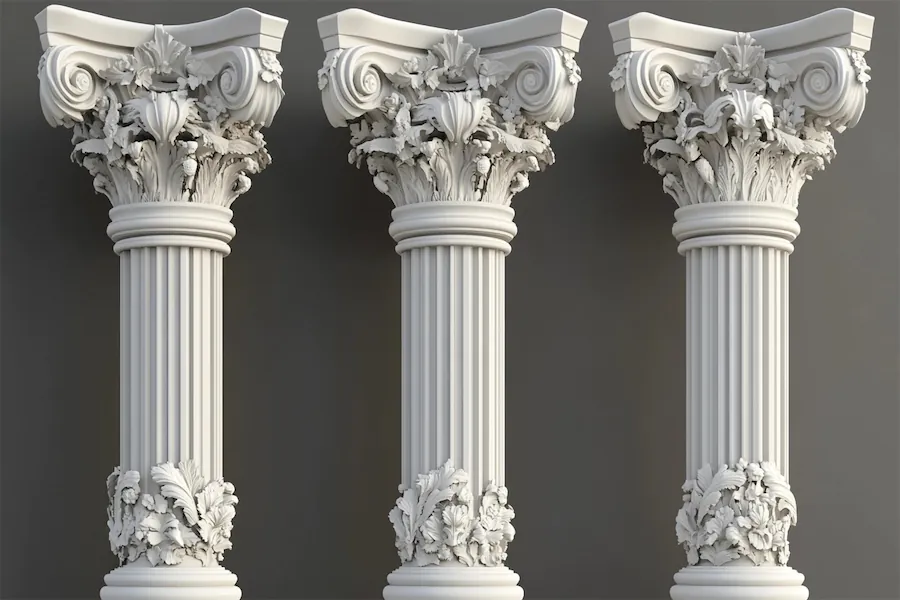Neo-Baroque architecture, also known as Baroque Revival, emerged in the late 19th and early 20th centuries as a revival of the opulent and dramatic Baroque style from the 17th and 18th centuries. This architectural movement sought to reintroduce the grandeur and ornamentation characteristic of the original Baroque period, adapting it to contemporary needs and sensibilities.
History and Origins of Neo-Baroque Columns
The Baroque period was known for its audacious and intricate designs, featuring complex geometries and lavish materials. These elements were often mixed with works of sculpture and other intricate building details. During the Baroque Age, architecture was used by the church to inspire local populations and by the ruling elite to showcase their immense wealth. The use of intricate, exuberant, and over-the-top detailing led to buildings that were equal parts sculpture and architecture.
In the late 19th century, there was a resurgence of interest in Baroque architecture, leading to the Neo-Baroque movement. This revival aimed to reintroduce the grandeur and ornamentation characteristic of the original Baroque period, adapting it to contemporary needs and sensibilities.
Key Features of Neo-Baroque Columns
Neo-Baroque columns are distinguished by several defining characteristics:
- Ornate Capitals: The capitals of Neo-Baroque columns are often intricately decorated, featuring elaborate carvings and motifs that draw inspiration from classical orders but are executed with the exuberance typical of the Baroque style.
- Solomonic Columns: These columns have a twisted or spiral shaft, creating a dynamic sense of movement. Originally used in Baroque architecture, Solomonic columns were revived in the Neo-Baroque period to add a dramatic flair to structures.
- Composite Order: The Composite order, combining elements of the Ionic and Corinthian orders, was favored in Neo-Baroque architecture for its richness and adaptability to ornate detailing. This order allowed architects to incorporate the volutes of the Ionic order with the acanthus leaves of the Corinthian, resulting in a highly decorative capital.
- Giant Order: Columns that span multiple stories, known as giant or colossal orders, were employed to convey grandeur and monumental scale in Neo-Baroque buildings. This feature was rare in antiquity but became more prevalent in Renaissance and Baroque architecture, and its revival in the Neo-Baroque period emphasized the imposing nature of such structures.
Applications of Neo-Baroque Columns
Neo-Baroque columns were utilized in various types of structures to evoke a sense of grandeur and opulence:
- Public Buildings: Government edifices and city halls often featured Neo-Baroque columns to symbolize power and authority. For instance, the Belfast City Hall in Northern Ireland, constructed in the Baroque Revival style, illustrates the power and prestige of Belfast during that period.
- Cultural Institutions: Opera houses, theaters, and museums incorporated these columns to enhance their aesthetic appeal and create an atmosphere of elegance. The Palais Garnier in Paris, completed in 1875, is a prime example of Neo-Baroque architecture, featuring elaborate Corinthian columns and lavish ornamentation.
- Religious Structures: Churches and cathedrals adopted Neo-Baroque elements, including ornate columns, to inspire awe and reflect the glory of religious traditions. The use of Solomonic columns, in particular, added a dynamic and spiritual quality to the interiors of these sacred spaces.
Considerations When Choosing Neo-Baroque Columns
When selecting Neo-Baroque columns for a project, several factors should be considered:
- Structural Integrity: Ensure that the columns are designed to support the intended loads, especially when employing complex designs like Solomonic twists.
- Material Selection: Choose materials that can be intricately carved and will withstand environmental conditions, such as stone or high-quality composites.
- Contextual Harmony: Consider the surrounding architectural styles to ensure that Neo-Baroque columns complement the existing environment and do not appear out of place.
- Maintenance Requirements: Ornate designs may require regular upkeep to preserve their intricate details and prevent deterioration over time.
Conclusion
Neo-Baroque columns represent a revival of the dramatic and ornate elements of Baroque architecture, adapted to the sensibilities of the late 19th and early 20th centuries. Characterized by their elaborate capitals, dynamic Solomonic twists, and monumental scales, these columns have been employed in various significant structures to convey grandeur and opulence. When incorporating Neo-Baroque columns into contemporary designs, it is essential to consider structural, material, contextual, and maintenance factors to ensure their enduring beauty and functionality.
